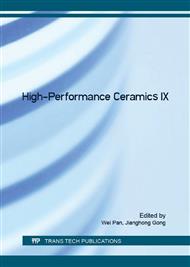[1]
W.M. Wang, Y.F. Zheng, H. Wang, Influence of hot pressing sintering temperature and time on microstructure and mechanical properties of TiB2 ceramics, J. Eur. Ceram. Soc. 22 (2002) 1045-1049.
DOI: 10.1016/s0955-2219(01)00424-1
Google Scholar
[2]
G.B. Raju, B. Basu, N.H. Tak, Temperature dependent hardness and strength properties of TiB2 with TiSi2 sinter-aid, J. Eur. Ceram. Soc. 29 (2009) 2119-2128.
DOI: 10.1016/j.jeurceramsoc.2008.11.018
Google Scholar
[3]
A. Mukhopadhyay, G.B. Raju, B. Basu, Correlation between phase evolution, mechanical properties and instrumented indentation response of TiB2-based ceramics, J. Eur. Ceram. Soc. 29 (2009) 505-516.
DOI: 10.1016/j.jeurceramsoc.2008.06.030
Google Scholar
[4]
L. Baca, Z. Lences, C. Jogl, Microstructure evolution and tribological properties of TiB2/Ni-Ta cermets, J. Eur. Ceram. Soc. 32 (2012) 1941-(1948).
DOI: 10.1016/j.jeurceramsoc.2011.10.039
Google Scholar
[5]
T.S.R. Ch. Murthy, B. Basu, A. Srivastava, Tribological properties of TiB2 and TiB2-MoSi2 ceramic composites, J. Eur. Ceram. Soc. 26 (2006) 1293-1300.
DOI: 10.1016/j.jeurceramsoc.2005.01.054
Google Scholar
[6]
A. Momozawa, R. Telle, Controlled precipitation of W2B4 platelets and of β-WB nanolaminates for the in situ reinforcement of ternary TiB2-W2B4-CrB2 ceramics, J. Eur. Ceram. Soc. 32 (2012) 85-95.
DOI: 10.1016/j.jeurceramsoc.2011.07.030
Google Scholar
[7]
A.S. Namini, S.N.S. Gogani, M.S. Asl, Microstructural development and mechanical properties of hot pressed SiC reinforced TiB2 based composite, Int. J. Refract. Met. H. 51 (2015) 169-179.
DOI: 10.1016/j.ijrmhm.2015.03.014
Google Scholar
[8]
J.P. Song, C.Z. Huang, M. Lv, Effects of TiC content and melt phase on microstructure and mechanical properties of ternary TiB2-based ceramic cutting tool materials, Mat. Sci. Eng. A. 605 (2014) 137-143.
DOI: 10.1016/j.msea.2014.03.036
Google Scholar
[9]
M.L. Gu, C.Z. Huang, B. Zou, Effect of (Ni, Mo) and TiN on the microstructure and mechanical properties of TiB2 ceramic tool materials, Mat. Sci. Eng. A. 433 (2006) 39-44.
DOI: 10.1016/j.msea.2006.07.012
Google Scholar
[10]
K.M. Taylor and R.J. Pallick, U.S. Patent 3, 765, 300. (1973).
Google Scholar
[11]
M.K. Aghajanian, B.N. Morgan, J.R. Singh, A new family of reaction bonded ceramics for armor application, Ceram. Trans. 134 (2002) 527-539.
Google Scholar
[12]
R. Voytovych, V. Bougiouri, N.R. Calderon, Reactive infiltration of porous graphite by NiSi alloys, Acta Mater. 56 (2008) 2237-2246.
DOI: 10.1016/j.actamat.2008.01.011
Google Scholar
[13]
Y.X. Wang, S.H. Tan, D.L. Jiang, The effect of porous carbon preform and the infiltration process on the properties of reaction-formed SiC, Carbon. 42 (2004) 1833-1839.
DOI: 10.1016/j.carbon.2004.03.018
Google Scholar
[14]
S. Hayun, N. Frage, M.P. Dariel, The morphology of ceramic phases in BxC-SiC-Si infiltrated composites, J. Solid State Chem. 179 (2006) 2875-2879.
DOI: 10.1016/j.jssc.2006.01.031
Google Scholar
[15]
D. Mallick, T.K. Kayal, J. Ghosh, Development of multi-phase B-Si-C ceramic composite by reaction sintering, Ceram. Int. 35 (2009) 1667-1669.
DOI: 10.1016/j.ceramint.2008.07.015
Google Scholar
[16]
C.P. Zhang, H.Q. Ru, W. Wang, The role of infiltration temperature in the reaction bonding of boron carbide by silicon infiltration, J. Am. Ceram. Soc. 97 (2014) 3286-3293.
DOI: 10.1111/jace.13085
Google Scholar
[17]
A.L. Yurkov, A.M. Starchenko, B.S. Skidan, Reaction sintering of boron carbide, Refract. Ind. Ceram. +. 30 (1989) 731-736.
DOI: 10.1007/bf01288282
Google Scholar
[18]
W.D. Callister, Materials science and engineering: an introduction, John Wiley & Sons Inc, New York, (2007).
Google Scholar
[19]
G.T. Hahn, The influence of microstructure on brittle fracture toughness, Metall. Trans. A. 15 (1984) 947-959.
DOI: 10.1007/bf02644685
Google Scholar
[20]
S.R. Choi, W.A. Sanders, J.A. Salem, Young's modulus, strength and fracture toughness as a function of density of in situ toughened silicon nitride with 4 wt% Scandia, J. Mater. Sci. Lett. 14 (1995) 276-278.
DOI: 10.1007/bf00275622
Google Scholar
[21]
R. Chaim, M. Hefetz, Effect of grain size on elastic modulus and hardness of nanocrystalline ZrO2-3 wt%Y2O3 ceramic, J. Mater. Sci. 39 (2004) 3057-3061.
DOI: 10.1023/b:jmsc.0000025832.93840.b0
Google Scholar
[22]
U. Engel, H. Hubner, Strength improvement of cemented carbides by hot isostatic pressing, J. Mater. Sci. 13 (1978) 2003-(2012).
DOI: 10.1007/bf00552908
Google Scholar
[23]
Q. Chang, D.L. Chen, H.Q. Ru, Toughening mechanism in iron-containing hydroxyapatite/titanium composites, Biomaterials. 31 (2010) 1493-1501.
DOI: 10.1016/j.biomaterials.2009.11.046
Google Scholar


